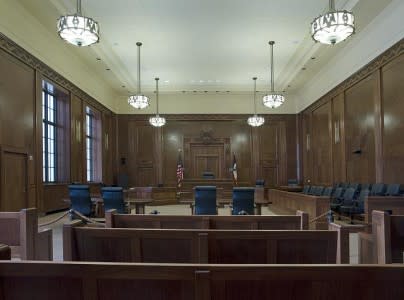Understanding an important First Amendment victory for reporters
The legal victory secured by Fox News reporter Jana Winter this week could mark an important milestone in the fight for a national law that protects journalists’ First Amendment rights.
Winter faced jail time in Colorado for refusing to name a confidential source in her reporting of the July 2012 Aurora movie theater shooting. After the incident, Winter reported that the accused killer, James Holmes, had sent a notebook containing disturbing images to his psychiatrist.
Winter’s news report appeared after a judge in Colorado imposed a gag order on the case. In January 2013, the court in Arapahoe County, Colo., where Holmes is being tried, concluded there was substantial evidence that unnamed law enforcement officials in Winter’s story had violated the gag order by giving her information.
“The potential violation of this court’s orders is a serious issue. The information about the package contents has received significant public attention that has implicated defendant’s constitutional rights to a fair trial, to a fair and impartial jury, and to due process as protected by the Fifth, Sixth, and Fourteenth Amendments,” said Arapahoe County District Judge William Sylvester.
Winter, as an employee of Fox News and its parent company News Corp., is based in New York City. The Colorado court asked New York to file a subpoena there, to compel Winter to travel to Colorado to testify, or possibly spend time in jail if she refused to name her sources.
Winter then filed a motion in Colorado to quash the subpoena, as a court in New York approved Colorado’s request. That set in motion an appeals process in New York since, courts in both states needed to approve the subpoena, to compel Winter to testify.
Nearly 50 media outlets filed briefs in support on Winter, who had lost the first legal round in her case in August 2013. Her attorney’s appealed to New York’s highest court, which ruled on the case on Tuesday.
Both Colorado and New York have shield laws that protect reporters from revealing sources. The Colorado law provides limited protection for journalists, since it only requires that a party in a case prove that evidence is “directly relevant” as required in the Supreme Court’s Branzburg v. Hayes decision from 1972.
New York state requires a much higher standard of proof—the evidence has to be so “critical or necessary” as to decide the entire case. It is considered an “absolute privilege” law.
In Branzburg, the Court said the First Amendment doesn’t protect reporters from testifying before a grand jury if they have witnessed a crime.
Justice Byron White wrote the majority opinion in the 5-4 decision, but it was a concurring opinion from Justice Lewis Powell that led to a greater movement toward state shield laws. Powell believed courts should balance the government’s need for information with a journalist’s right to protect sources.
Currently, only Wyoming doesn’t have a state shield law or a court-recognized privilege for reporters.
The New York Supreme Court Appellate Division court ruled in a 3-2 verdict against Winter in August, and it said that Colorado’s weaker law took precedence.
“The narrow issue before the Supreme Court was whether respondent should be compelled to testify, and privilege and admissibility are irrelevant for this determination,” the court said. “Respondent is entitled to assert whatever privileges she deems appropriate before the Colorado District Court.”
The state’s highest court overturned the decision by a 4-3 vote, pointing out the state’s history of protecting journalists dates back to before the Constitution.
The Court of Appeals alluded to the case of printer John Peter Zenger, who was tried for publishing articles the criticized New York’s governor – in 1735, and acquitted.
“Although there are uncertainties concerning the application of the outer reaches of our statute, particularly the scope of the qualified privilege for nonconfidential news which must be determined on a case-by-case basis … there is no principle more fundamental or well-established than the right of a reporter to refuse to divulge a confidential source,” said Associate Judge Victoria Graffeo.
Graffeo added that her state was ahead of the U.S. Constitution when it came to First Amendment rights.
“Article I, § 8 of the New York Constitution – our guarantee of free speech and a free press — was adopted in 1831, before the First Amendment was rendered applicable to the states. … The drafters chose not to model our provision after the First Amendment, deciding instead to adopt more expansive language.”
“We therefore conclude that an order from a New York court directing a reporter to appear in another state where, as here, there is a substantial likelihood that she will be compelled to identify sources who have been promised confidentiality would offend our strong public policy – a common law, statutory and constitutional tradition that has played a significant role in this State becoming the media capital of the country if not the world,” she said.
Judge Robert Smith didn’t agree with the opinion, calling it “an excessive expansion of New York’s jurisdiction” since Winter was physically in Colorado when she interviewed her sources.
For now, the appeals process has ended in the case and Winter won’t face a court in Colorado. And the publicity over her predicament focuses more attention on the need for a national shield law.
President Obama has supported a national shield law for journalists, especially in the wake of the NSA surveillance revelations.
Congress is considering such a law, called the Free Flow of Information Act. But the bill has been stalled as lawmakers debate the 21st Century definition of a journalist, and the effects that disclosures from sources like Edward Snowden have had on journalism.
Recent Constitution Daily Stories
Legal pot states banking on Thursday secret panel meeting
Constitution Check: Should police need a court order to get cellphone call data?



